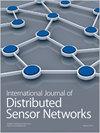A distributed energy-efficient opportunistic routing accompanied by timeslot allocation in wireless sensor networks
IF 2.5
4区 计算机科学
Q3 COMPUTER SCIENCE, INFORMATION SYSTEMS
International Journal of Distributed Sensor Networks
Pub Date : 2022-05-01
DOI:10.1177/15501477211049917
引用次数: 5
Abstract
Sensed data can be forwarded only in one direction to the base station in one-dimensional queue wireless sensor networks different from mesh structure, so the network lifetime will be shortened if some continuous neighboring nodes have run out of their energy. So designing routing protocols for balancing energy consumption is a challenging problem. However, traditional and existing opportunistic routing protocols for one-dimensional queue wireless sensor network proposed so far have not yet addressed this problem to prolong the network lifetime by introducing sleep mode. In this article, we propose a distributed energy-efficient opportunistic routing algorithm accompanied by timeslot allocation by using specific network topology of one-dimensional queue wireless sensor network. In our new algorithm, clustering and routing tree construction is performed while introducing the optimal relay transmission distance achieved by using opportunistic routing principle, and at the same time, interference-free wake up time is scheduled, which may optimize energy consumption and decrease the number of various control messages as possible to prolong the network lifetime. Furthermore, this improves energy efficiency by introducing the operation mode giving up cluster head role. Simulation results show that the proposed protocol can significantly improve the network performance such as energy consumption and network connectivity, when compared with other existing protocols.无线传感器网络中具有时隙分配的分布式节能机会路由
不同于网状结构的一维队列无线传感器网络中,感知到的数据只能单向转发到基站,如果相邻连续节点的能量耗尽,会缩短网络的生存时间。因此,设计均衡能耗的路由协议是一个具有挑战性的问题。然而,目前提出的一维队列无线传感器网络的传统和现有机会路由协议都没有通过引入睡眠模式来解决这一问题,延长网络的生存时间。本文利用一维队列无线传感器网络的特定网络拓扑结构,提出了一种带有时隙分配的分布式节能机会路由算法。该算法在引入机会路由原理实现的最优中继传输距离的同时进行聚类和路由树构建,同时调度无干扰唤醒时间,从而优化能耗,尽可能减少各种控制消息的数量,延长网络寿命。此外,通过引入放弃簇头角色的运行模式,提高了能效。仿真结果表明,与现有协议相比,该协议能显著提高网络能耗和网络连通性等性能。
本文章由计算机程序翻译,如有差异,请以英文原文为准。
求助全文
约1分钟内获得全文
求助全文
来源期刊
CiteScore
6.50
自引率
4.30%
发文量
94
审稿时长
3.6 months
期刊介绍:
International Journal of Distributed Sensor Networks (IJDSN) is a JCR ranked, peer-reviewed, open access journal that focuses on applied research and applications of sensor networks. The goal of this journal is to provide a forum for the publication of important research contributions in developing high performance computing solutions to problems arising from the complexities of these sensor network systems. Articles highlight advances in uses of sensor network systems for solving computational tasks in manufacturing, engineering and environmental systems.

 求助内容:
求助内容: 应助结果提醒方式:
应助结果提醒方式:


